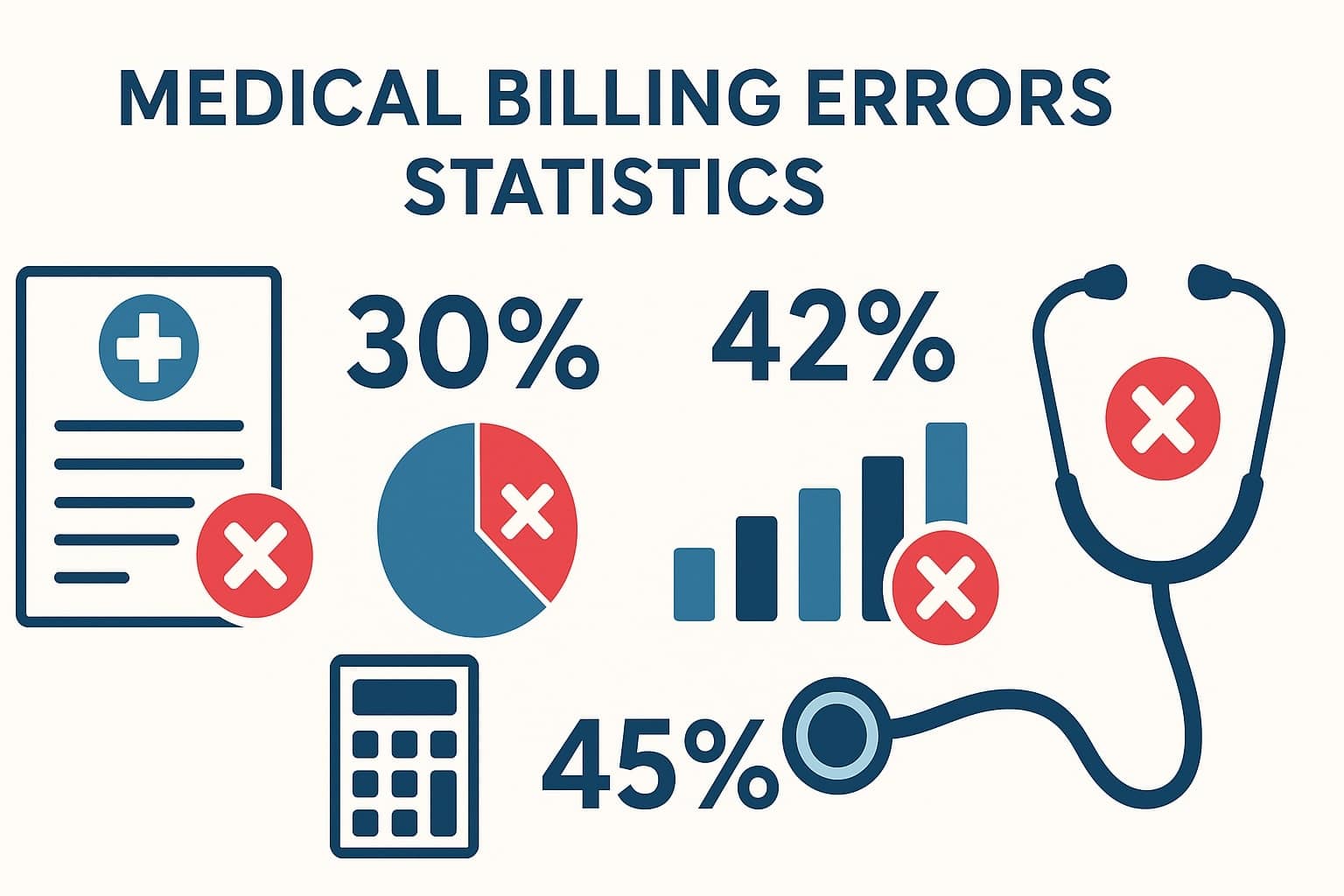
Medical billing is a complex process prone to human and system errors. Current data suggests roughly 80% of medical bills in the U.S. contain some form of error. These billing errors not only frustrate patients and providers but also carry serious financial consequences, and the only solution is medical coding and billing services.
Healthcare providers collectively lose an estimated $125 billion per year (about $5 million per provider on average) due to suboptimal billing practices. Medical billing errors can lead to denied claims, delayed payments, added rework costs, and even compliance penalties. You can also check the medical billing company rates to get an average cost for your medical billing services.
Below you will find 9 common medical billing mistakes that impact revenue and how to avoid them. Along the way, real examples, best practices, and why the right software is essential for a healthy revenue cycle.
-
Inaccurate Patient or Insurance Information
One of the simplest errors is submitting claims with incorrect patient demographics or insurance details. A misspelled name, an incorrect date of birth, or an invalid insurance ID can lead to an immediate claim rejection.
Nearly half of healthcare BPO providers report that patient information mistakes are a top cause of claim denials. Small typos can translate into significant revenue delays.
Best Practice: Double-check patient data at registration and again before submitting claims. Leverage EHR or billing software features (like validation checks and real-time eligibility lookups) to catch errors and ensure the patient’s coverage and personal details are up to date for every visit.
-
Failure to Verify Insurance and Coordination of Benefits
Not verifying insurance coverage or coordination of benefits (COB) before providing services is a frequent billing error in healthcare.
If a patient’s insurance is inactive or if there’s an undisclosed secondary insurer, the claim may be denied or only partially paid. Skipping eligibility checks can mean you only discover after a denial that the wrong payer was billed or that the plan required prior authorization.
Best Practice: Verify insurance eligibility and COB for each patient visit. Use your software or clearinghouse to perform real-time checks and confirm which payer is primary.
Identifying insurance changes or requirements upfront ensures you bill the correct party and meet any pre-approval rules, preventing avoidable denials.
-
Lack of Prior Authorization or Referral
Certain tests, procedures, and specialist visits require prior authorization or referrals, and failing to secure these is a common billing mistake. Even if the service was medically necessary, the insurer can deny payment if proper pre-approval wasn’t obtained.
For example, performing an MRI or surgery without the insurer’s authorization will likely result in a denial.
Best Practice: Integrate authorization checks into your scheduling and ordering process. Before the patient is seen, confirm if the planned service needs pre-approval and obtain it when required.
Many practice management systems can flag services that typically require authorization. By securing authorizations and referrals in advance (and noting them on the claim), you greatly reduce the risk of avoidable denials.
-
Coding Errors and Inaccuracies
In fact, common medical coding errors, such as using the wrong diagnosis or procedure code, are a major cause of claim denials. Using an outdated code or a diagnosis code that isn’t specific enough can trigger a rejection.
For example, billing an appendectomy with an unspecified diagnosis code will likely be denied for lack of specificity. On hospital claims, even misassigning a revenue code can result in denial if it doesn’t align with the procedure performed.
Best Practice: Keep your coding up to date and precise. ICD-10 and CPT code sets change regularly, so make sure your team and software use the latest versions. Use claim-scrubbing tools that flag coding issues before submission. Always code to the highest level of detail supported by the documentation to prove medical necessity and avoid denials.
-
Incorrect Use of Modifiers
Modifiers (two-digit codes added to CPT codes) provide extra details about how a service was provided. Not using a required modifier or using one incorrectly can lead to denied or improper payments.
For example, if multiple procedures occur on the same day but no modifier differentiates them, the payer may assume a duplicate service and deny one of the charges. On the other hand, overusing certain modifiers (like modifier -25 for separate E/M services) can draw insurer scrutiny.
Best Practice: Ensure your billing staff understands when and how to apply modifiers. Follow official CPT guidelines and payer-specific rules. Use billing software edits that prompt for appropriate modifiers in common scenarios. Correct modifier usage helps you receive full reimbursement without unnecessary denials.
-
Unbundling and Upcoding
Unbundling and upcoding are coding missteps that can lead to denials and even legal trouble. Unbundling means billing separate codes for parts of a procedure that should be billed together under one comprehensive code. Upcoding means using a higher-level code (with higher reimbursement) than what was performed or documented. Moreover, intentional upcoding is illegal under federal law.
Best Practice: Code each service accurately and ethically. If a set of services has a single bundled code, use it instead of unbundling. Emphasize to your team that accuracy is more important than inflating codes. Regular internal audits can catch inadvertent upcoding or unbundling. It’s better to bill correctly than to risk audits or fines from overbilling.
-
Duplicate Billing
Duplicate billing happens when the same service is billed more than once, usually by mistake.
For example, a claim might be re-submitted by accident, or two staff members might unknowingly bill the same procedure. Payers typically spot exact duplicates and will reject the second claim, but this still causes delays and extra work. In severe cases, frequent duplicate billing can raise red flags about a provider’s billing practices.
Best Practice: Implement controls to prevent duplicate submissions. Good practice management systems will warn you if a charge has already been billed. If you must correct and refile a claim, use proper adjustment codes or reference the original claim rather than sending it as a new claim. Careful record-keeping and reconciliation of submitted claims ensure each service is billed only once.
-
Insufficient Documentation or Medical Necessity
Even when the codes are correct, poor documentation can result in non-payment. Insurers may deny a claim if the medical necessity isn’t evident from the record or if required documentation (like accident details for injury claims) is missing.
For example, a high-level office visit billed without detailed supporting notes might be down-coded or denied upon review.
Best Practice: Make documentation a priority. Providers should clearly record the rationale for each service and level of care billed. Ensure all necessary information (e.g. dates of injury or referral notes) is included when applicable. Your billing team should double-check that documentation is complete and submit any additional records the payer requires. Solid documentation not only prevents denials but also protects you during audits.
-
Missing Filing Deadlines (Timely Filing)
Every insurer has a time limit for claim submission, and missing that deadline means an automatic denial. Timely filing limits can range from a few months to a year after the service date. If a claim isn’t submitted within the allowed window (or corrected and resubmitted within the grace period after a rejection), the payer will simply refuse to pay.
Best Practice: Track and adhere to all filing deadlines. Configure your billing system to flag approaching deadlines for each payer and aim to submit claims promptly (ideally within days of the service). If a claim is initially rejected, correct it and resubmit as soon as possible to still meet the deadline.
Medical Billing Errors Statistics
Medical billing errors impact nearly eight in ten claims, with industry reports estimating that 80 % of medical bills contain mistakes, costing providers over $6.2 billion each year in denied claims and lost reimbursements. Improper payment rates in Medicare Fee-for-Service have risen to 7.66 %, equating to $31.7 billion in erroneous payments in FY 2024. Most of these errors, about 69.8 %, stem from insufficient documentation (59.8 %) and incorrect coding (10.0 %), underscoring persistent claim accuracy and compliance challenges.
The Role of Medical Billing Software in Error Prevention
Considering the complexity of billing, modern software is one of the best defenses against mistakes. A good medical billing system automates many tasks, verifying insurance, flagging coding issues, and ensuring required fields are filled, which significantly reduces human error. Such software can scrub claims for omissions before submission and keep your CPT/ICD code sets up to date automatically.
The result is fewer denials and faster reimbursement. Some advanced platforms even use analytics or AI to identify common error patterns so you can address issues proactively. Ultimately, technology streamlines the billing workflow by catching errors, ensuring compliance, and freeing staff to focus on patient care.
Conclusion
Minimizing billing mistakes directly boosts your practice’s financial health. Every denied or delayed claim is revenue left on the table and extra work for your staff. By tackling the pitfalls above and using the right tools, you can significantly reduce billing errors in healthcare and enjoy a smoother, more predictable revenue cycle.
At AffinityCore, we’ve helped practices large and small strengthen their billing processes, from cleaning up claims to deploying cutting-edge software, to maximize revenue and reduce headaches. These best practices will help your team, but a trusted partner can amplify the results. With our medical billing services supporting your revenue cycle, you can focus on patient care while we handle the coding, claims, and compliance details, effectively turning potential medical billing errors into accurate reimbursements. Also, check our Neurology Billing Services.
Sources:
- Dialog Health – Medical Billing Statistics: From Errors to Economic Impact
- BillFlash – Staggering Statistics: Medical Billing and Payments
- Experian Health – Medical Billing Software: The Future of RCM
- Carrington College – Common Medical Billing and Coding Errors
- Maryland Dept. of Health – Common Billing Mistakes Causing Denials
- EdgeMed – Six Common Medical Billing and Coding Errors
- Omega Healthcare – 6 Medical Coding Mistakes (Law Office summary)


